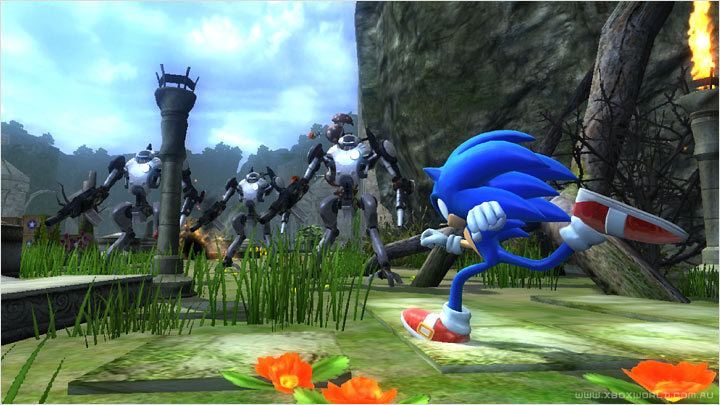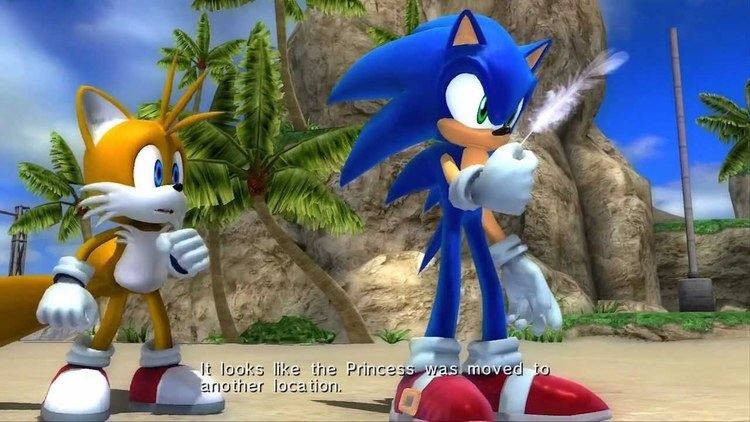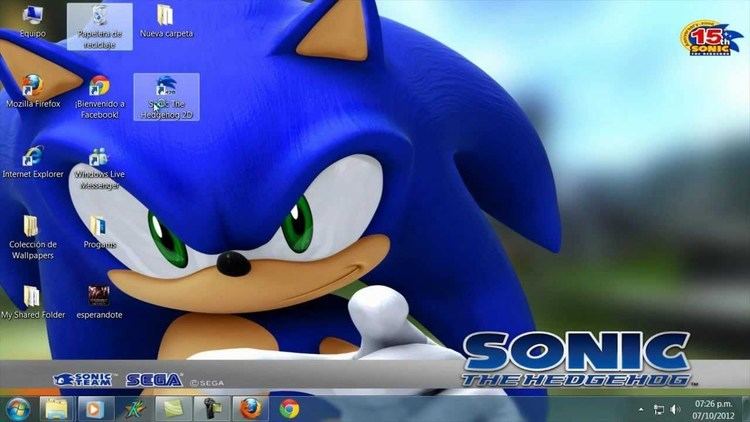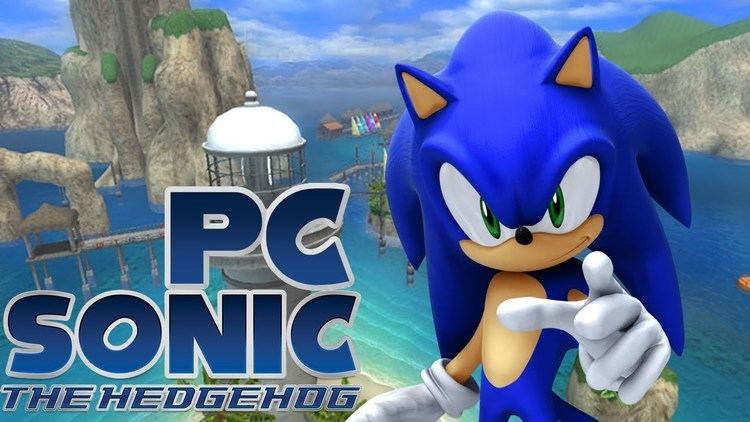4.8 /10 1 Votes
Artist(s) Akira Mikame | 4.8/10 IGN Producer(s) Masahiro Kumono Initial release date 14 November 2006 | |||||||||||||||||||||||||||||||||
 | ||||||||||||||||||||||||||||||||||
Writer(s) Shun NakamuraKiyoko YoshimuraShiro Maekawa Composer(s) Hideaki KobayashiTomoya OhtaniMariko NanbaTaihei SatoTakahito Eguchi Similar | ||||||||||||||||||||||||||||||||||
Sonic the Hedgehog (ソニック・ザ・ヘッジホッグ, Sonikku za Hejjihoggu) is a 2006 platform video game in the Sonic the Hedgehog series developed by Sonic Team and published by Sega for the PlayStation 3 and Xbox 360 video game consoles. The game was produced in commemoration of the series' fifteenth anniversary. To avoid confusion with the original 1991 video game of the same name, the game is often referred to with colloquial names that reference its year of release, such as Sonic '06. Sonic the Hedgehog follows Sonic's quest to protect Princess Elise after she is kidnapped by his rival Dr. Eggman, while Shadow the Hedgehog faces a supernatural entity and Silver the Hedgehog tries to protect the world from a forthcoming cataclysmic event. Players control the three each in separate campaigns; however, each character's abilities set them apart and allow them to access different parts of a series of levels.
Contents

Sonic the Hedgehog was announced in 2005 and was envisioned as being an innovative reboot of the franchise. Anticipation was high; however, the game faced multiple issues during development, which resulted in Sonic Team rushing the product for its targeted Christmas 2006 release despite existing bugs. Both versions gained notability for receiving negative reception; it was criticized for long loading times, a poor camera system, gameplay glitches, a complicated plot, and sloppy character control. Sonic the Hedgehog was de-listed from retailers in 2010, following Sega's decision to remove all Sonic titles with sub-average Metacritic scores to increase the value of the brand.

Gameplay

Sonic the Hedgehog is a three-dimensional platform game with action-adventure and role-playing elements. The main player characters are the titular Sonic, Silver or Shadow the Hedgehog, but others are available for short periods. The main three characters are controlled in separate campaigns titled "stories". Sonic's levels generally focus on speed-based platforming similar to that of Sonic Adventure, with some sections having him run at full speed while dodging obstacles; others see him escorting Princess Elise, who can guard him with a special barrier. Shadow's sections are similarly speedy, though some segments see him riding vehicles, such as a motorcycle. In contrast, Silver's levels move at a slower pace, and revolve around his use of telekinesis to defeat enemies and solve puzzles. In certain areas, control is switched to a friend character (Tails or Knuckles for Sonic, Rouge or Omega for Shadow, and Amy or Blaze for Silver), each with their own abilities.

Although every character plays the same levels, each character's unique abilities allow the player to access different areas of each stage and deny the player from accessing certain items. Scattered around levels are golden rings, which serve as a form of health: if a character has at least one in their possession and is hit by an enemy, they will survive, although their rings will be scattered and blink before disappearing. Sonic, Shadow, and Silver start the game with a limited number of lives. A life is lost when the characters are struck by an enemy attack without rings or suffer any other type of damage. If the player runs out of lives, the game is over. In each story, the player navigates through hub worlds, known as Town Stages, where they can converse with townspeople to progress the story. The main gameplay takes place in Action Stages that become accessible as the game progresses.

The game features two multiplayer modes: "Tag", where two players must work together to clear levels and collect Chaos Emeralds; and "Battle", a multiplayer mode where two players race against each other. Several downloadable extensions have been released that add features to single-player gameplay. These include "Very Hard" mode, a more difficult version of the game; "Boss Attack" modes, which allow a playable character to engage in continuous battles with all of the game's bosses; and "Team Attack Amigo" mode, which sends players through a multitude of levels in a set order, changing to a different "amigo" character every two or three levels, culminating in a boss fight.
Plot
The game follows Sonic, Shadow, and Silver in a story intertwined in their respective gameplay modes.
In Soleanna, the Festival of the Sun's opening ceremony is disrupted by the arrival of Doctor Ivo "Eggman" Robotnik, who seeks the "Flames of Disaster" from Princess Elise. Sonic arrives and attempts to save her, but fails when he is attacked by Eggman's robots. Before being taken away, Elise gives Sonic the blue Chaos Emerald. The next day, Sonic meets Tails in the city; the two chase Eggman's aircraft carrier through a beach before rescuing Elise in the desert. Meanwhile, Shadow saves Rouge the Bat, who drops the Scepter of Darkness, causing it to release Mephiles the Dark, a supernatural entity in Shadow's image who claims Shadow sealed him within the scepter ten years ago. Mephiles opens a wormhole which transports Shadow and Rouge to the future: a post-apocalyptic world that is caused by the Flames of Disaster, who is revealed to be a fiery monster named Iblis.
There, Silver the Hedgehog and Blaze the Cat, two survivors trying to fend off the creature, meet Mephiles, who claims Sonic to be the "Iblis Trigger" and sends the two back in time using the purple Chaos Emerald. Silver and Blaze are separated upon arrival, with Silver witnessing Eggman's attack on Soleanna and Sonic's departure. He meets Amy Rose, who accompanies him to find Sonic but defends him when they find him, while Eggman recaptures Elise. Sonic flees and meets with Tails and Knuckles the Echidna, before Eggman lures them into a trap and sends them into the future, where Tails discovers Elise died one day before Iblis was released. Still in the future, Shadow and Rouge find a shutdown E-123 Omega and later unite with Sonic, Tails and Knuckles. Using two Chaos Emeralds, Sonic, Tails, Rouge, and Knuckles return to the present, and Rouge sends the Omega of the present to the future to assist Shadow. The two face Mephiles and learn that in the future Shadow was imprisoned by Omega after being falsely accused of causing the destruction. Shadow and Omega then return to the present-day.
In the present, Sonic chases Eggman and Elise at a train terminal before being attacked again by Silver; however, Shadow intervenes. Shadow and Silver travel ten years into the past and learn Iblis and Mephiles are parts of the Duke of Soleanna's project to harness the power of the city's god Solaris. After an explosion sets the two free (and fatally wounds the Duke), the Duke gives Shadow the Scepter of Darkness, which he uses to seal Mephiles, while Silver and the Duke seals Iblis into a young Elise's tears. The Duke reveals to Silver that Elise's tears will release Iblis, and comforts his daughter before dying. In the present, Sonic fails to reach Eggman's destroyed ship with Elise inside it, but Silver sends Sonic back in time so he can save Elise. While Shadow, Rouge, and Omega defeat Mephiles' clones, Silver and Blaze stop Iblis in the future by sealing the creature in Blaze's soul, who then uses Chaos Control to seal herself in an alternate dimension.
After surviving Shadow's attack, Mephiles holds up the purple Chaos Emerald in use and seemingly kills Sonic with an energy blade behind him, causing Elise to cry and unleash Iblis. Mephiles bonds with Iblis, recreating Solaris, ripping the time-space continuum apart. As everyone mourns Sonic's apparent death, Elise senses that Sonic may still be alive and Silver realizes that the Chaos Emeralds can revive him. After Tails, Knuckles, Silver, Shadow, Rouge, Amy, and Omega gather the emeralds, Elise gives Sonic a kiss, which allows him to transform into his super form. Sonic transfers some of his power to Shadow and Silver, and together they defeat Solaris. Sonic and Elise go back in time, finding Solaris' original form as a single white flame. Elise blows out the candle to erase Solaris from existence (and the game's events) so that Solaris can befriend Elise again, rebooting the timeline. The game ends with Sonic watching Elise in the festival show; the two display signs of faintly recalling their friendship.
Development
Sonic the Hedgehog had a troubled development, and multiple frequently discussed features were scrapped before the game was released.
The game began development after the completion of Billy Hatcher and the Giant Egg, and was first announced at the Electronic Entertainment Expo convention in May 2005. At the 2005 Tokyo Game Show convention, Yuji Naka revealed the game's official title, Sonic the Hedgehog, and also announced that the game would celebrate the fifteenth anniversary of the Sonic the Hedgehog series. In an interview with GameSpy, Naka additionally confirmed that the game would use the Havok engine, previously used in Sega's PlayStation 2 Astro Boy video game. Game director Shun Nakamura demonstrated the game's use of the engine during Sega's stage shows as well.
Sonic the Hedgehog was intended to give a more realistic vision of the Sonic series. For this reason, human characters, including Doctor Eggman, are given a photorealistic design. Various planned features were dropped during development, such as a night/day mechanic (which was later implemented in 2008's Sonic Unleashed). At one point in development, Sonic Team even considered giving Sonic realistic fur and rubber textures. The character of Silver went through more than fifty concepts, initially being conceived of as a mink before becoming a hedgehog. The game additionally features several CGI animated cutscenes, produced by Blur Studio.
After its debut, the game's development team began to face several serious problems, starting with the resignation of Yuji Naka as the head of Sonic Team. Sonic the Hedgehog was originally intended for release on all major consoles, but when presented with development kits for the Nintendo Wii (which is considerably less powerful than the Xbox 360 and PlayStation 3, the hardware the game was designed for), it was decided that Sonic the Hedgehog's staff would be split in two, with Shun Nakamura finishing the creation of Sonic the Hedgehog for Xbox 360 and PS3, while Yojiro Ogawa would use the other half of Sonic Team to begin work on a new Sonic game (later revealed to be Sonic and the Secret Rings) for the new Nintendo platform. Due to the split, the staff was left with an unusually small development team to work on Sonic the Hedgehog. In order to release the game in time for the Christmas season, Sonic Team rushed the development period, ignoring existing bugs and control issues.
In a February 2007 interview for Kikizo magazine, Sonic Team producer Yojiro Ogawa was asked to comment on the game's glitches, control problems and loading times:
The reason why we probably ended up with what we see today, involves a lot of reasons. One is that we did want to launch the title around Christmas, and we had the PS3 launch coming up, but we had to develop for Microsoft's 360 at the same time and the team had an awful lot of pressure on them. It was very hard for the team to try and see how we were going to come out with both versions together with just the one team. It was a big challenge.
Music
The main theme for the game, "His World", written by Tomoya Ohtani, was performed by Ali Tabatabaee and Matty Lewis of the band Zebrahead. R&B artist Akon performed a remix of the Dreams Come True song "Sweet Sweet Sweet", a song originally from their 1992 album The Swinging Star, and was also used as the ending theme to Sonic the Hedgehog 2. The game's official soundtrack, titled Sonic the Hedgehog Original Soundtrack, was released physically and digitally on January 10, 2007.
Release
Sonic the Hedgehog was first released for the Xbox 360 in North America on November 14, 2006, followed by the PlayStation 3 version on January 30, 2007. The game was also made available on Xbox Live's Games on Demand service.
In September 2010, various Sonic games with average or below average Metacritic ratings, including Sonic the Hedgehog, were de-listed from retailers in order to increase the value of the brand after the positive reception to Sonic the Hedgehog 4: Episode I and Sonic Colors.
Pre-release
Pre-release reactions to Sonic the Hedgehog were positive. Reception to prior entries in the series, namely Sonic Heroes and Shadow the Hedgehog had been more lukewarm, so anticipation was high for the game, with some calling the game a possible return to the series' roots. Ricardo Torres of GameSpot claimed the game "showed a considerable amount of promise" after its showing at the Electronic Entertainment Expo in 2006.
Post-release
Sonic the Hedgehog was notable for gaining negative reception upon its release, with aggregating review website Metacritic assigning the Xbox 360 version a 46/100, and the PS3 version a 43/100. Reviewers heavily criticized the game's camera system, extensive loading times, poor controls, and several gameplay glitches; Jeff Gerstmann of GameSpot labeled Sonic the Hedgehog as "a mess from top to bottom". Juan Castro of IGN said that the game "offers a few good ideas, and a handful of exciting moments, but none of this helps the game recover from a catastrophic loss in control", while GameTrailers concluded that the game was "flat-out unfinished, unfairly difficult, and most importantly, just isn't much fun." GameTrailers also ranked the game #9 in their countdown of the "Top Ten Most Disappointing Games of the Decade." In 2009, GamesTM ranked it #1 on their top ten "Video Game Franchises That Lost Their Way," commenting that "The blue hedgehog's next-gen efforts have been nothing short of appalling, none more so than his 2006 appearance."
Dave Halverson of Play Magazine initially gave Sonic the Hedgehog a 9.5/10 score for the Xbox 360 version, praising each character's controls and abilities and calling it the best 3D Sonic game yet. In the following issue, however, Halverson reassessed it as 8.5/10, citing that he was incorrectly told that the load times and glitches in his review copy would not be in the final version of the game. In a later review for the PS3, Halverson was frustrated with the glitches and load times not being improved upon, as well as how the game ran marginally worse despite the extra development time; Halverson gave the PS3 version a 5.5/10. Bobbi Dempsey of Common Sense Media gave it one out of five stars, also criticizing the game's "atrocious" design problems and the "quirky" control system, asserting that it's "not even a renter."
The game's plot was also not well received. GamesRadar called the story "ridiculously overwrought" and "conceptually challenged", while GameTrailers commented that the plot was "pretty ridiculous stuff" and that "You might actually be better off reading Internet fan fiction." Gertsmann stated that "While the character variety might initially seem like a good idea, most of them aren't too interesting". GameTrailers also commented that "even if you like the characters, the convoluted manimal melodrama is poor quality", while Eurogamer mentioned that "Rather than fleshing the game out, the supporting cast often just annoys." Game Informer, however, opined that "The story, though outlandish and nonsensical at first, eventually incorporates an interesting mix of interweaving time travel, pathos, and all-star teamwork to defeat an ancient evil."
The implied romance between Sonic the Hedgehog and the human Princess Elise was especially criticized. GamesRadar called their kiss "the most bizarrely cringe-worthy kiss in video game history," and in another article, concluded about the pairing that "True love has never been so disgusting." GamesTM stated "...Sonic's relationship and kiss with Princess Elise truly marked the point the [Sonic] series had veered off into absolute nonsense." When asked during an interview whether anyone might accuse the game of supporting bestiality, actress Lacey Chabert, who provides Elise's voice in the game, stated, "Ha! No, you're just being silly. It's not an inappropriate relationship. Let's just say Sonic and Princess Elise have an attraction for each other."
Legacy
Most characters introduced in the game have made no further appearances in the Sonic series. Elise's only appearance outside Sonic the Hedgehog was a minor cameo in Sonic Rivals 2. Silver, however, has appeared as a playable character in both Sonic Rivals and its sequel, Sonic Riders: Zero Gravity, and Mario & Sonic at the Olympic Winter Games, and was a minor supporting character in the Nintendo DS version of Sonic Colors.
To celebrate the Sonic franchise's 20th anniversary, Sega released Sonic Generations, a game that remade aspects of various past games from the franchise. The PlayStation 3, Xbox 360, and PC version contained a remake of the "Crisis City" level. Additionally, every version of the game, including the Nintendo 3DS version, contains a remake of the boss battle with Silver. The decision to include Sonic the Hedgehog stages and bosses in Sonic Generations was controversial; Jim Sterling of Destructoid referred to the Silver boss fight as the "catch" of the game.
In 2017, a demo for a fan-made PC port of Sonic the Hedgehog developed in Unity was released.
